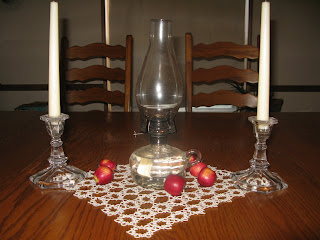
I did the first bit of Christmas shopping last week. The weather here was so warm for so long that it seemed to go strait from summer to winter, and along with winter... the holidays! I felt so unprepared!!! Since our middle daughter's birthday is December 1st, we don't decorate for Christmas until after her birthday. I don't want her birthday to be swallowed up with Christmas trees and stockings. However, I do like to have most, if not all, the Christmas shopping done by then. I'll tell you a little secret... I hate shopping, and I LOATHE malls! But what's most abhorant to me of all is the unashamed, greedy credit card wielders.On second thought, no, I dont' abhore them, I pity them. Perhaps it's not greed (well, not all of it anyways.) Perhaps more often than not it's simply discontentedness. A lost people who have no real purpose or don't abide in the Purpose they do have, and seek to fill the void with the sparkle and shine of every new gadget and what-ama-call-it the stores offer. (I am making a very broad generalization , and I'm quite sure you, dear reader, do not fall into this catagory.) The problem with all the flash and glitter is that, come January, its glory fades. Now all that's left is the mountain of garbage bags filled with crumpled wrapping paper and torn boxes, a credit card bill that is as long as Santa's toy list was, and a heap of "stuff" that has to made room for in closets or on toy shelves. And on top of it all, there is usually no more good chocolate left to console oneself with (all that's left are the waxy chocolates with the pink junk in the middle that looks like it should be delectable, but somehow reminds you of silly putty when you bite into it... you know the ones I'm talking about.)
So what to do about it? I honestly don't know.... for you that is. For me, I chose to simplify. Fist of all, we don't buy our children ton's of gift. There is no reason that children need more than a few. (I had to learn great self-control to turn away from buy any one of a million - and there really are millions - things that I know would put a smile on their precious little faces.) I purchase or make a couple of things, usually of my choosing, that I know will make them happy for a long time to come and not be tossed into the toy box not to be seen again for months or years. This not only teaches them that it is ok to not get everything you want (which is why most Americans, and even our government, are so greatly in debt. I firmly believe that a little self-denial is a healthy thing) but it encourages them to treat the few things they do receive with greater appreciation and care. I don't want to run my household like the throw-away society that has become our nation.
Starting the first paycheck after Christmas I put a pre-determined amount of cash into an enveloped marked "Christmas," and I continue to put the same amount of money in the envelope each and every paycheck for one full calendar year. That is my Christmas budget. And I don't break it. That means that when I want to buy my hubby that fishing pole for only $25 more than this fishing pole, I buy this one. It means that I would really love to get just that one extra little (fill in the blank)... I simply don't! Right now, our family Christmas budget is $600, and that includes EVERYTHING pertaining to Christmas, decorations, cards and stamps, cookie making ingredients, and gifts for the extended family as well. It means that we generally don't get to spend more than $50 per person actually living in our house. And do you know what? We're happy!!! Last year I didn't even put the presents under the tree until Christmas Eve. Instead I put our Nativity scene under the tree as a reminder of the true Christmas gift!
It isn't easy to balance out the constant pull of a commercialized Christmas, but if I do not fight back and make a concious effort to capture the true meaning of Christmas in my childrens' hearts, I only contribute to the Enemy's efforts: to draw attention away from our precious Christ! When Christmas comes around each and every year for the rest of my childrens' lives, I want them to be full to the brim with joy in their Purpose! and not seek aimlessly for shallow purpose at a mall, credit card at the ready.
(Stepping off of soap box... walking away)
